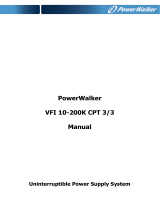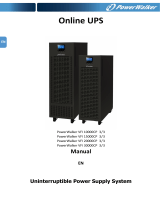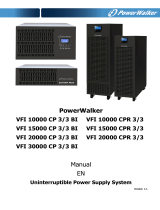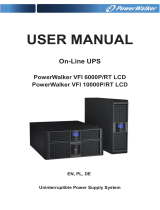
2
Outdoor.
*for temperature and humidity limits please check product specification
2. Inspect the packaging carton and its contents for damage. Please inform the transport agency
immediately should you find signs of damage.
3. Inspect the unit, make sure that nothing is damaged.
4. Please keep the packaging in a safe place for future use (e.g. storage, transportation).
5. Condensation may occur if the UPS system is moved directly from a cold to warm environment. The
UPS system must be absolutely dry before being installed. Please allow at least two hours for the UPS
system to acclimate the environment.
6. The utility power outlet shall be near the equipment and easily accessible.
IV. Installation
1. To reduce the risk of overheating the UPS, do not cover the cooling vents.
Input connection
2. Please use only original approved CE-marked input cable to connect the UPS to power.
3. Connect the UPS system only to a grounded (two-pole, three-wire) shockproof outlet which must be
easily accessible and close to the UPS system.
4. Do not plug the UPS into its output.
5. Place cables in such a way that no one can step on or trip over them.
Output connection
6. Please use only approved CE-marked power cables to connect the loads to the UPS system.
7. The connected equipment must not exceed the UPS unit’s rated power capacity. Otherwise, an
overload condition may occur and cause the UPS unit to shut down or trip the circuit breaker.
8. During the installation of the equipment, it should be assured that the sum of the leakage currents
of the UPS and the connected loads does not exceed 3.5mA.
9. Do not connect any load with high in-rush current, because it may damage the unit. For small line
interactive type UPS, even a laser printer or scanner can create a problematic surge, while for online
type UPSs it could be caused by a motor.
10. Carefully connect household or other appliances to the UPS output, because many of them can
overload the UPS (e.g. vacuum cleaners, hair dryers, etc).
11. Refrain from connecting a power strip or surge limiter to the UPS’s output, as power strips might
have a higher rating than the UPS.
Communication and signalling
12. For models with a communication port, connect the appropriate cable (e.g. USB or RS232 between
UPS and PC)
13. USB port and RS-232 port cannot work at the same time.
14. For models with RJ11/RJ45 surge protection, you can connect a modem or a phone line to RJ11/RJ45
“IN” port on the back panel of the UPS unit. Connect from “OUT” port to the computer with another
cable. This will protect your equipment from surges on a communication cable.
15. Please be aware that surge protection might limit your Internet bandwidth.
16. In selected models, EPO plug (Emergency Power Off) is used to remotely shut down the UPS in case
of emergency (it should not be used for regular switching off the unit). Typically EPO is wired into
the building’s safety installation and connected to emergency power off button installed at the
entrance. It is used by fire brigades to shut down the electricity in the whole building, including














